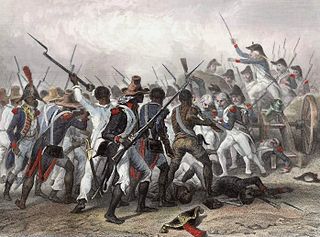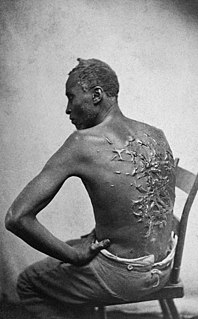Related Research Articles
The slave narrative is a type of literary genre involving the (written) autobiographical accounts of enslaved Africans, particularly in the Americas. Over six thousand such narratives are estimated to exist; about 150 narratives were published as separate books or pamphlets. In the United States during the Great Depression (1930s), more than 2,300 additional oral histories on life during slavery were collected by writers sponsored and published by the Works Progress Administration, a New Deal program. Most of the 26 audio-recorded interviews are held by the Library of Congress.

The Underground Railroad was a network of secret routes and safe houses established in the United States during the early- to mid-19th century. It was used by enslaved African Americans primarily to escape into free states and Canada. The network was assisted by abolitionists and others sympathetic to the cause of the escapees. The enslaved who risked escape and those who aided them are also collectively referred to as the "Underground Railroad". Various other routes led to Mexico, where slavery had been abolished, and to islands in the Caribbean that were not part of the slave trade. An earlier escape route running south toward Florida, then a Spanish possession, existed from the late 17th century until approximately 1790. However, the network now generally known as the Underground Railroad began in the late 18th century. It ran north and grew steadily until the Emancipation Proclamation was signed by President Abraham Lincoln. One estimate suggests that by 1850, 100,000 enslaved people had escaped via the network.

Slavery in the United States was the legal institution of human chattel slavery, comprising the enslavement primarily of Africans and African Americans, that existed in the United States of America from its founding in 1776 until the passage of the Thirteenth Amendment in 1865. Slavery was established throughout European colonization in the Americas. From 1526, during early colonial days, it was practiced in Britain's colonies, including the Thirteen Colonies which formed the United States. Under the law, an enslaved person was treated as property and could be bought, sold, or given away. Slavery lasted in about half of U.S. states until 1865. As an economic system, slavery was largely replaced by sharecropping and convict leasing.
Master/slave is a model of asymmetric communication or control where one device or process controls one or more other devices or processes and serves as their communication hub. In some systems, a master is selected from a group of eligible devices, with the other devices acting in the role of slaves.

Bleeding Kansas, Bloody Kansas, or the Border War was a series of violent civil confrontations in Kansas Territory, and to a lesser extent in western Missouri, between 1854 and 1859. It emerged from a political and ideological debate over the legality of slavery in the proposed state of Kansas.
Polly Berry, also known as Polly Crockett and Polly Wash, was an African-American woman notable for winning two freedom suits in St. Louis, Missouri, one for herself, which she won in 1843, and one for her daughter Lucy, which she won in 1844. She sued for her own freedom based on having been held illegally as a child slave in the free state of Illinois. In 1842 Berry sued for the freedom of her daughter Lucy Ann Berry, as the girl had legally been born to a free woman. That case was argued by Edward Bates, the future U.S. Attorney General under President Abraham Lincoln.

Slavery in New Jersey began in the early 17th century, when Dutch colonists trafficked African slaves for labor to develop their colony of New Netherland. After England took control of the colony in 1664, its colonists continued the importation of slaves from Africa. They also imported "seasoned" slaves from their colonies in the West Indies and enslaved Native Americans from the Carolinas.

The history of slavery in Kentucky dates from the earliest permanent European settlements in the state, until the end of the Civil War. Kentucky was classified as the Upper South or a border state, and enslaved African Americans represented 24% by 1830, but declined to 19.5% by 1860 on the eve of the Civil War. The majority of enslaved people in Kentucky were concentrated in the cities of Louisville and Lexington, in the fertile Bluegrass Region as well the Jackson Purchase, both the largest hemp- and tobacco-producing areas in the state. In addition, many enslaved people lived in the Ohio River counties where they were most often used in skilled trades or as house servants. Few people lived in slavery in the mountainous regions of eastern and southeastern Kentucky. Those that did that were held in eastern and southeastern Kentucky served primarily as artisans and service workers in towns.

When the Dutch and Swedes established colonies in the Delaware Valley of what is now Pennsylvania, in North America, they quickly imported African slaves for workers; the Dutch also transported them south from their colony of New Netherland. Slavery was documented in this area as early as 1639. William Penn and the colonists who settled Pennsylvania tolerated slavery, but the English Quakers and later German immigrants were among the first to speak out against it. Many colonial Methodists and Baptists also opposed it on religious grounds. During the Great Awakening of the late 18th century, their preachers urged slaveholders to free their slaves. High British tariffs in the 18th century discouraged the importation of additional slaves, and encouraged the use of white indentured servants and free labor.
Digital history is the use of digital media to further historical analysis, presentation, and research. It is a branch of the digital humanities and an extension of quantitative history, cliometrics, and computing. Digital history is commonly digital public history, concerned primarily with engaging online audiences with historical content, or, digital research methods, that further academic research. Digital history outputs include: digital archives, online presentations, data visualizations, interactive maps, time-lines, audio files, and virtual worlds to make history more accessible to the user. Recent digital history projects focus on creativity, collaboration, and technical innovation, text mining, corpus linguistics, network analysis, 3D modeling, and big data analysis. By utilizing these resources, the user can rapidly develop new analyses that can link to, extend, and bring to life existing histories

Invisible churches among enslaved African Americans in the United States were informal Christian groups where enslaved people listened to preachers that they chose without their slaveholder's knowledge. The Invisible churches taught a different message from white-controlled churches and did not emphasize obedience. Some slaves could not contact invisible churches and others did not agree with an invisible church's message but many slaves were comforted by the invisible churches.

The 1842 Slave Revolt in the Cherokee Nation was the largest escape of a group of slaves to occur in the Cherokee Nation, in what was then Indian Territory. The slave revolt started on November 15, 1842, when a group of 20 African-American slaves owned by the Cherokee escaped and tried to reach Mexico, where slavery had been abolished in 1829. Along their way south, they were joined by 15 slaves escaping from the Creek Nation in Indian Territory.

Freedom suits were lawsuits in the Thirteen Colonies and the United States filed by enslaved people against slaveholders to assert claims to freedom, often based on descent from a free maternal ancestor, or time held as a resident in a free state or territory.

The treatment of slaves in the United States varied by time and place, but was generally brutal, especially on plantations. Whipping and rape were routine, but usually not in front of white outsiders, or even the plantation owner's family.
The following is provided as an overview of and topical guide to databases:
In the field of database design, a multi-model database is a database management system designed to support multiple data models against a single, integrated backend. In contrast, most database management systems are organized around a single data model that determines how data can be organized, stored, and manipulated. Document, graph, relational, and key–value models are examples of data models that may be supported by a multi-model database.

The Centre for the Study of the Legacies of British Slavery, formerly the Centre for the Study of the Legacies of British Slave-ownership, is a research centre of University College, London (UCL) which focuses on revealing the impact of British slavery and, in particular, the implications of the Slave Compensation Act 1837. The Centre's work is freely available online to the public through the Legacies of British Slavery database.

The history of slavery in Florida predates the period of European colonization and was practiced by various indigenous peoples. Florida had some of the first African slaves in what is now the United States in 1526-1565, as well as the first emancipation of escaping slaves in 1687 and the first settlement of free blacks in 1735.

Slavery as a positive good was the prevailing view of white Southern U.S. politicians and intellectuals just before the American Civil War, as opposed to seeing it as a crime against humanity or even a necessary evil. They defended the legal enslavement of people for their labor as a benevolent, paternalistic institution with social and economic benefits, an important bulwark of civilization, and a divine institution similar or superior to the free labor in the North.

African American genealogy is a field of genealogy pertaining specifically to the African American population of the United States. African American genealogists who document the families, family histories, and lineages of African Americans are faced with unique challenges owing to the slave practices of the Antebellum South and North. These challenges rise from a range of events, including name changes following the American Civil War, the act of separating families for sale as slaves, lack of issued birth or death records for slaves, etc.
References
- 1 2 Seefeldt, Douglas; Thomas, William G. (May 2009), "What is Digital History? A Look at Some Exemplar Projects", Perspectives on History, Washington, D.C.: American Historical Association, 47 (5), ISSN 1556-8563
- 1 2 Torget, Andrew J. (2007). "Mapping the Borders of Slavery: The Texas Slavery Project". Center for Digital Research in the Humanities. Archived from the original (Abstract) on May 10, 2014. Retrieved October 27, 2009.
- ↑ Torget, Andrew J. (2007). "Andrew Torget, University of Virginia". Lincoln, NE: Digital History. Archived from the original (Interview) on April 21, 2009. Retrieved October 27, 2009.
- ↑ Arthur, Paul (March 2008), "Exhibiting History: the Digital Future" (PDF), reCollections: Journal of the National Museum of Australia., Canberra, Australia, 3 (1): 33–50, 41, ISSN 1833-4946